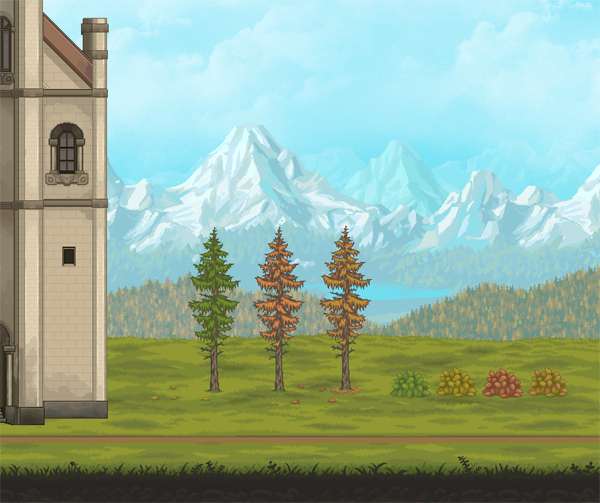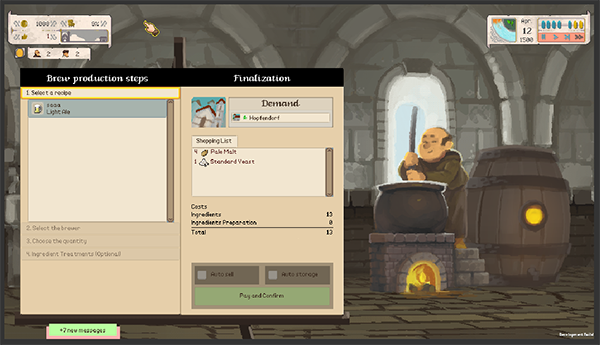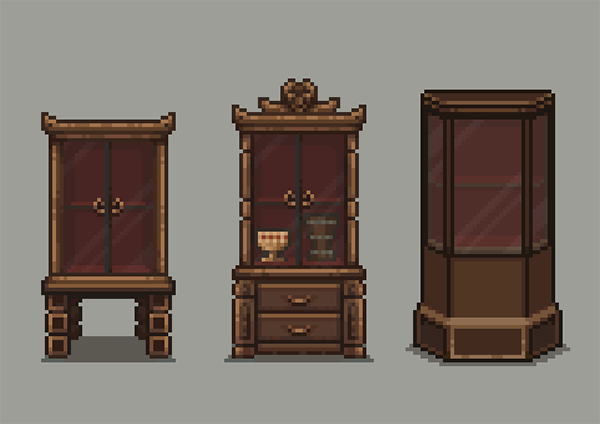Hello once again and thank you for joining us for another Something's Brewing, the one place we discuss Ale Abbey, our upcoming Monastery Brewery tycoon!
Back on track to normal speeds and this means continuing the work on multiple fronts again, three to be precise. We worked on an extra piece of furniture that should feed your need for vanity, got some progress in the brewing scene UI, and we're almost finished with an Autumn look for the Abbey's surroundings.
Keep reading to find out more ;)
-- Autumn is here! (not really)
After finishing the Winter version for the main biome, we did mention Emiliano was itching for some pumpkin spice lattes Autumn colors. Our pixel artist Raimo, in but a few days worked on the color palettes, prepared a few examples for the trees and bushes (green is the "control group" of the bunch shown underneath), and of course worked on the surrounding hills and a little less moody mountaintops.

Leaves you can practically hear the crunchiness off! Oh, and that grass is not as green as you might think it is (compared to the default Summer version). Next stop: Spring.
-- Update on Brewing UI
With the amount of work put into the Recipe Crafting UI, we have raised the bar as to how the other crucial part of the beer brewing process looks. This is of course the Brewing itself, the second of the two pillar mechanics of Ale Abbey.

More polish to follow so keep an eye out, with the happy monk ready to be animated, this one's a very promising one!
-- Does anyone like trophies?
Cause they're coming! It's not that you need to get a trophy for making ale that stands out, but the long process (or short, depending on your brewing and trading prowess) of getting a town's reputation to 100% has to be rewarded somehow. We're still talking about a monastery, but a bit of pride here and there should give some motivation to you and your little brewers.
Raimo went all out and completed a triplet of Display Cabinets for us to choose from and the finalist we're leaning towards is the left from the ones shown below:

So although we're quite happy with the selected Display Cabinet, the trophies themselves have not arrived yet. The curios you see above are from the Cabinet of Curiosities and served us well as placeholders, so we hope you're up for some more bling, soon.
-- Was good ale appreciated?
Forget what you've seen in period films where beer of the time always looked like a hot mess that everyone drunk, but nobody liked. Good beer in the late Middle Ages was appreciated to quite an extend.
As one would expect, for monasteries that brewed ale, the quality of their brews was celebrated within the community. High-quality monastic ale often drove donations from local patrons and increased trade, and monasteries known for their excellent ale could gain prestige and influence. Not very far from what happens in Ale Abbey, come to think of it...
In some regions, particularly in England, there were local festivals or feasts where the best ales were showcased and consumed. Brewers whose ales were highly regarded might receive public recognition during these events. In some cases, they could even be given symbolic awards or honors by the local lord or other officials.
But the appreciation of good ale didn't stop at "street cred." Local authorities had a say more often than not. Brewers who consistently produced high-quality ales could be granted certain privileges by the local authorities, such as exemptions from certain taxes or even the exclusive right to brew and sell ale in a particular area.
Ale-Conners were local officials appointed by towns or villages to ensure the quality and fairness of ale production. These officials would visit alehouses and taverns, taste the ale, and determine if it met the required standards. If the ale was found to be good, the brewer could continue selling it. If it was poor, the ale might be condemned, and the brewer could face fines or other penalties. Ale-Conners sometimes held public ceremonies where they would taste the ale in front of the townspeople, making their approval or disapproval a communal event (which could make or break a brewery...).
And finally, the "Assize of Ale" was a set of regulations that governed the production and sale of ale, particularly in England. These regulations included standards for the quality and price of ale. Brewers who consistently produced high-quality ale within these regulations were rewarded with a good reputation and the ability to charge higher prices. Those who failed to meet the standards, though... you get the picture.
With this, we'll let you enjoy your weekend responsibly, but remember to join us next week for some more Ale Abbey news!
-- Hammer & Ravens
Wishlist (and tell your friends!)
Craving for more Ale Abbey? Maybe looking to chat with the team and our community? Follow:
Ale Abbey on
Our studio, Hammer & Ravens, on Discord or:






